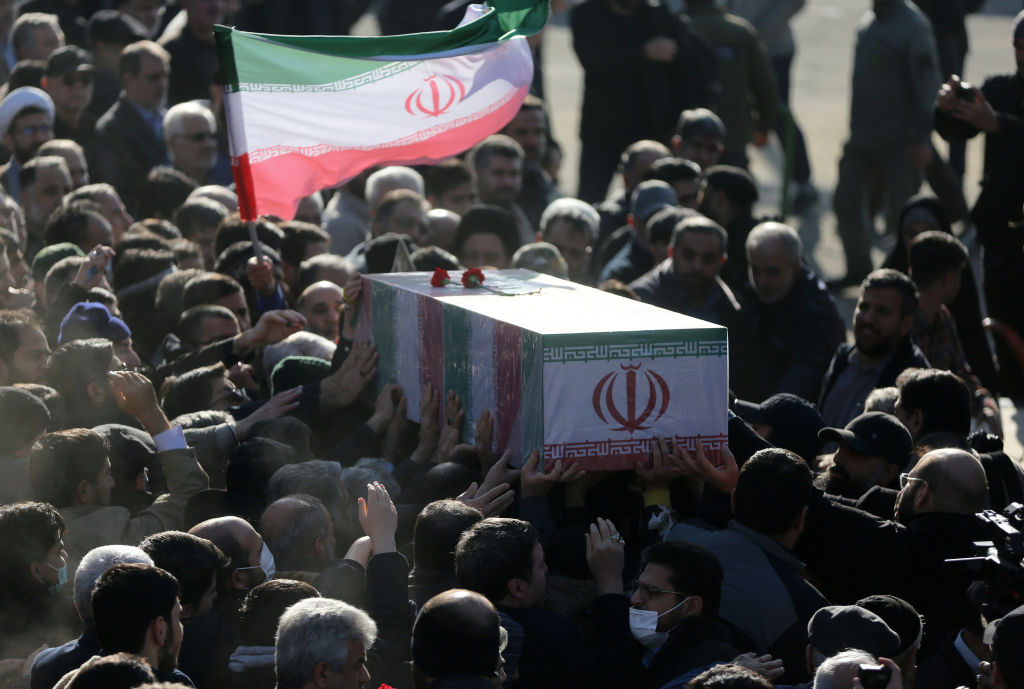Combat activity continued over the weekend in the Gulf Region. On the same day US forces led a multiplatform air strike against Iran proxies in Iraq and Syria, Iran-supplied Houthi rebels continued to launch unmanned aerial vehicles (UAV) at merchant vessels attempting to transit the Red Sea. Fortunately, American and Allied naval vessels are also in the Red Sea. On February 2, US Navy destroyers and F/A-18s destroyed eight Houthi UAVs in the air and four on the ground preparing to launch.
New information on the US raids of Iran proxies in Syria and Iraq confirmed that Jordanian F-16 fighter jets took part in the US air attacks on seven target locations. Jordan has skin in the game since the Iran-backed proxies attacked a US outpost in Jordan on January 28, killing three American soldiers. Furthermore, “[T]here is a long history of Iran-backed proxy groups attacking Jordanian border areas regularly as part of an elaborate drug smuggling effort to finance Iran’s Islamic Revolutionary Guard Corps [IRGC] activities in Syria,” Chris Pandolfo posted for Fox News.
Iran at the Center of Widening Conflict in Gulf Region
 It is becoming clear, despite the Biden administration’s protestations to the contrary, that the Gulf Regional conflict has expanded, and other nations are taking responsibility for defending the Red Sea and Bab al-Mandab Strait. Additionally, the US and Jordanian combined airstrikes against Islamic Resistance in Iraq may not have had the behavior modification impact the Biden administration had hoped. The day after the US raid, though the Islamic Resistance in Iraq was silent, “IRGC-controlled and local Syrian media also claimed that the Islamic Resistance in Iraq conducted drone and rocket attacks targeting US forces stationed at the al Tanf garrison, Homs Province, and Rumaylan Landing Zone, Hasakah Province, Syria,” according to an Institute for the Study of War report.
It is becoming clear, despite the Biden administration’s protestations to the contrary, that the Gulf Regional conflict has expanded, and other nations are taking responsibility for defending the Red Sea and Bab al-Mandab Strait. Additionally, the US and Jordanian combined airstrikes against Islamic Resistance in Iraq may not have had the behavior modification impact the Biden administration had hoped. The day after the US raid, though the Islamic Resistance in Iraq was silent, “IRGC-controlled and local Syrian media also claimed that the Islamic Resistance in Iraq conducted drone and rocket attacks targeting US forces stationed at the al Tanf garrison, Homs Province, and Rumaylan Landing Zone, Hasakah Province, Syria,” according to an Institute for the Study of War report.
The US, along with an international coalition of forces, responded again on February 3 to the continued provocations by the Iran-sponsored Houthis with a broader target set. US Central Command (USCENTCOM) posted: “[A]t 11:30 p.m. (Sanaa time), US Central Command forces, alongside UK Armed Forces and with the support from Australia, Bahrain, Canada, Denmark, the Netherlands, and New Zealand conducted strikes against 36 Houthi targets at 13 locations in Iranian-backed Houthi terrorist-controlled areas of Yemen.” The number of targets included a variety of “underground storage facilities, command and control, missile systems, UAV storage and operations sites, radars, and helicopter,” the X post reported.
More recently on February 4, USCENTCOM forces executed an air strike in Yemen against the Iran-sponsored Houthis that were preparing to launch anti-ship cruise missiles at US Navy ships and merchant vessels in the waterways around Yemen. With the broader range of targets focused on Iran proxies and surrogates across the Gulf Region, it’s harder to believe the Biden administration’s claim that operations in the Red Sea and against Islamic Resistance in Iraq aren’t part of a coordinated effort. The fact that the expanded and increased frequency of Iran proxy attacks on US military bases and outposts began in earnest after the murderous Hamas attack on southern Israel on October 7 is ample confirmation of the larger regional conflict.
Biden Showing Weakness
By leaving Iran unscathed, the Biden administration exhibits what is taken as fear to engage the number one sponsor of terrorism around the world. Recent airstrikes on Iran proxies combined the full weight of bombers flying from the United States, cruise missiles launched from US Navy ships in the region, and F/A-18s flying from a US aircraft carrier, USS Dwight D. Eisenhower. Nonetheless, the immense sea power doesn’t provide the deterrence the Biden administration would like if the major culprit inciting conflict, Iran, believes it’s safe from retaliation. Hezbollah in Lebanon, the remnant of Hamas in Gaza, and Islamic Resistance in Iraq are all tied to Iranian support.
Though the killing of three American military service members prompted a major air strike on selected Iran-backed proxy targets and then more bombs dropped on different locations, essentially, it was more of the same type of punitive response seen in the past. There has been nothing in the way of US retaliation that would give Iran itself pause for its further involvement in attacks on shipping in the Red Sea or missile and drone assaults on US forces in Iraq and Syria.
The views expressed are those of the author and not of any other affiliation.




